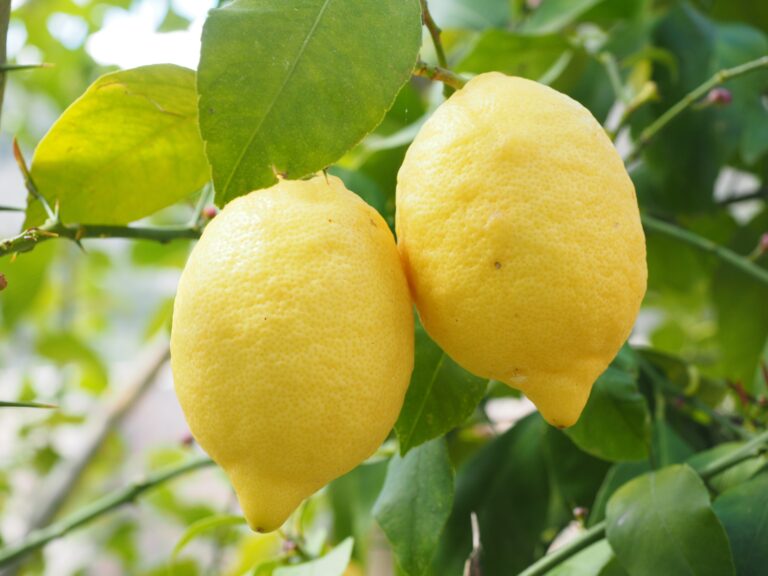Why Do Lemons Float and Limes Sink?
Citrus fruits like lemons and limes are not only known for their vibrant flavors but also for an interesting phenomenon – lemons tend to float in water, while limes sink. This seemingly simple occurrence has sparked curiosity among many, prompting the question: Why do lemons float and limes sink? In this article, we’ll delve into the science behind this phenomenon and explore ten reasons that contribute to the buoyancy differences between lemons and limes.
Why Do Lemons Float and Limes Sink?
1. Density Variation
Lemons and limes exhibit differences in density, a key factor influencing their behavior in water. Lemons, with their slightly lower density compared to limes, are more buoyant, causing them to float. The density variation stems from differences in the composition of the fruits, including water content, essential oils, and other compounds.
Density and Buoyancy
The density of an object determines whether it will float or sink in water. Lemons, having a lower density than water, experience a buoyant force greater than their weight, causing them to float. Limes, with a higher density, tend to sink as the buoyant force is insufficient to counteract their weight. This fundamental principle of buoyancy sheds light on the contrasting behaviors of lemons and limes when placed in water.
Citrus Fruit Composition
The composition of lemons and limes contributes significantly to their density. Lemons typically have a higher water content and lower oil content, making them less dense. Limes, on the other hand, may have a higher oil content and different proportions of water, resulting in a denser composition. Understanding the intricate balance of these components helps unravel the mystery of why lemons float while limes sink.
2. Porous Rind Structure
The rind, or peel, of lemons and limes plays a crucial role in their buoyancy. The porous structure of the rind allows air to be trapped within its layers, affecting the overall density of the fruit.
Air Trapping Mechanism
Lemon rinds possess a more porous structure compared to lime rinds. This allows lemons to trap more air within their peels, increasing their overall buoyancy. The trapped air acts as a buoyant force, contributing to the upward force exerted on the lemon when placed in water. In contrast, the denser and less porous lime rinds trap less air, leading to their tendency to sink.
Buoyancy and Rind Structure
The relationship between buoyancy and rind structure is evident in the way air is distributed within the citrus fruit. The more porous the rind, the more air can be trapped, influencing the overall buoyancy of the fruit. Examining the microscopic structure of lemon and lime rinds provides insights into the mechanics of their buoyant behavior.
3. Citrus Oil Content
The presence of essential oils in citrus fruits contributes to variations in their buoyancy. Lemons and limes contain different concentrations of these oils, impacting their overall density.
Impact of Essential Oils
Lemons generally have a lower oil content compared to limes. Essential oils are less dense than water, so a higher oil concentration in limes increases their overall density, making them more likely to sink. The lesser oil content in lemons, in contrast, contributes to their lower density and buoyant nature.
Buoyancy and Oil Distribution
Understanding how essential oils are distributed within the fruit provides valuable insights into the buoyancy dynamics. The distribution of oils in the peel and flesh of lemons and limes influences their overall density, affecting whether they float or sink in water.
4. Water Absorption Rates
The ability of citrus fruits to absorb water also contributes to their buoyancy. Variations in water absorption rates between lemons and limes impact their behavior when placed in water.
Water Absorption in Lemons
Lemons tend to absorb water at a slower rate due to their thicker rinds and lower porosity. This slower water absorption minimizes the increase in overall density, allowing lemons to maintain their buoyancy for a more extended period.
Water Absorption in Limes
Limes, with thinner and more porous rinds, absorb water more rapidly. The increased water absorption leads to a quicker rise in density, causing limes to become submerged in water. Examining the water absorption rates provides a comprehensive understanding of the factors influencing the buoyancy of lemons and limes.
Buoyancy and Water Absorption
The relationship between water absorption and buoyancy showcases how the structural characteristics of citrus fruits influence their interaction with water. Observing the changes in water absorption rates highlights the dynamic nature of this buoyancy phenomenon.
5. Size and Volume Considerations
Beyond composition, the size and volume of lemons and limes contribute to their buoyancy. Differences in these physical characteristics affect how the fruits displace water and experience buoyant forces.
Displacement and Buoyancy
When placed in water, both lemons and limes displace a volume of water equal to their size. However, the larger size of lemons means they displace a greater volume of water, enhancing their buoyancy. Limes, being smaller, displace less water, reducing the buoyant force acting on them.
Buoyancy and Fruit Size
Examining the relationship between fruit size and buoyancy provides valuable insights into the mechanics of floating and sinking. The greater volume of water displaced by larger lemons showcases the significance of size in determining the buoyancy of citrus fruits.
6. Temperature Effects on Density
Temperature can influence the density of liquids, including water, which in turn impacts the buoyancy of lemons and limes. Understanding these temperature effects provides a holistic view of the factors at play.
Temperature and Water Density
Water density changes with temperature. Warmer water tends to be less dense than cooler water. When lemons and limes are placed in water, the temperature of the water can influence the buoyancy of the fruits based on these density variations.
Buoyancy and Temperature Relationships
Exploring the relationship between buoyancy and temperature sheds light on the role of environmental factors in determining the behavior of lemons and limes in water. Observing how temperature affects water density helps unravel the intricacies of this buoyancy phenomenon.
7. Juice Content and Buoyancy
The juice content of lemons and limes contributes to their buoyancy dynamics. Variations in juice composition and distribution influence how the fruits interact with water.
Juice Distribution in Lemons
Lemons typically have a higher juice content, which is distributed throughout the fruit. The even distribution of juice contributes to the buoyancy of lemons, counteracting the denser components and promoting their ability to float.
Juice Distribution in Limes
Limes may have a lower juice content compared to lemons, and the distribution of juice may vary. The impact of juice distribution on the overall buoyancy of limes underscores the importance of examining the internal composition of citrus fruits.
Buoyancy and Juice Composition
Analyzing the relationship between juice composition and buoyancy provides insights into the role of internal factors in determining whether lemons float or limes sink. Understanding how juice content influences the buoyancy of citrus fruits enhances our grasp of this intriguing phenomenon.
8. Maturity and Ripeness Levels
The maturity and ripeness of lemons and limes can influence their buoyancy. Changes in fruit texture, firmness, and composition as they ripen contribute
to the observed differences in behavior.
Texture Changes in Lemons
As lemons mature and ripen, there are changes in their texture. These changes, including a softening of the fruit, can impact the overall buoyancy. Understanding how maturity levels influence buoyancy provides valuable insights into the lifecycle of citrus fruits.
Texture Changes in Limes
Similar to lemons, the ripening process affects the texture of limes. Changes in firmness and composition as limes ripen contribute to their buoyancy dynamics. Examining the impact of ripeness on buoyancy enhances our understanding of the factors at play.
Buoyancy and Ripeness
The correlation between ripeness and buoyancy highlights the dynamic nature of this phenomenon. Observing how maturity levels influence the behavior of lemons and limes in water deepens our appreciation for the complex interplay of factors determining buoyancy.
9. Varietal Differences
Different varieties of lemons and limes may exhibit unique characteristics that influence their buoyancy. Varietal differences in size, composition, and other factors contribute to the observed variations in behavior.
Unique Traits of Lemon Varieties
Distinct varieties of lemons may have unique characteristics, such as size, shape, and composition. Exploring how these traits impact buoyancy provides a nuanced understanding of the differences between lemon varieties.
Unique Traits of Lime Varieties
Lime varieties, too, can exhibit variations in size, shape, and composition. Examining how these unique traits influence the buoyancy of different lime varieties enriches our understanding of the factors contributing to the sinking behavior.
Buoyancy and Varietal Characteristics
Understanding the influence of varietal characteristics on buoyancy allows us to appreciate the diversity within the citrus family. Exploring how different varieties behave in water provides a comprehensive view of the factors shaping the buoyancy of lemons and limes.
10. Environmental Factors
Environmental conditions, such as air pressure and altitude, can impact the buoyancy of lemons and limes. Examining these external factors adds another layer of complexity to the understanding of this intriguing phenomenon.
Air Pressure Effects
Changes in air pressure can influence the buoyancy of objects in water. The variation in air pressure at different altitudes or locations may contribute to differences in how lemons and limes float or sink.
Altitude and Buoyancy
Altitude, with its impact on air pressure, can affect the buoyancy of citrus fruits. Observing how environmental factors alter the behavior of lemons and limes in water broadens our understanding of the multifaceted nature of buoyancy.
Buoyancy and Environmental Influences
Considering the influence of environmental factors on buoyancy underscores the interconnectedness of various elements at play. Exploring how external conditions shape the behavior of lemons and limes in water provides a holistic perspective on this captivating phenomenon.
Conclusion
In conclusion, the buoyancy differences between lemons and limes are the result of a complex interplay of factors, encompassing the fruits’ density, rind structure, oil content, water absorption rates, size, temperature effects, juice composition, maturity levels, varietal differences, and environmental factors. Each of these aspects contributes to the observed behavior of lemons floating and limes sinking in water. By unraveling the intricacies of this phenomenon, we gain a deeper appreciation for the scientific principles governing the buoyancy of citrus fruits. Whether for culinary curiosity or scientific exploration, the contrasting behaviors of lemons and limes continue to intrigue and inspire further investigation.




